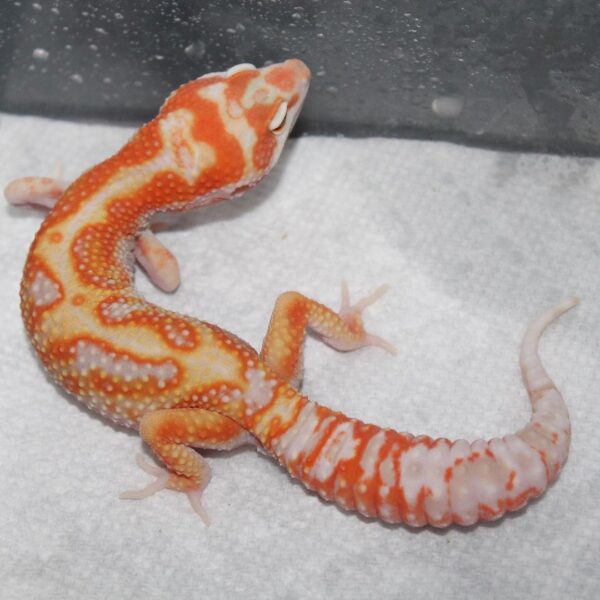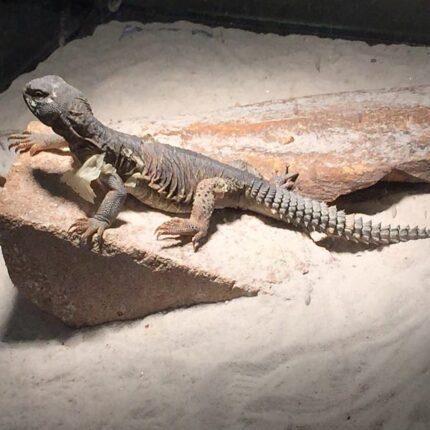Small Mangrove Monitors are a beautiful and exotic reptile that we’ve been a fan of for a while, and we’re not the only ones. Interest in keeping them as pets has definitely increased in recent years!
But attempting to own these lizards is something that we only recommend for experts. Their habitat requirements and temperament are not beginner-friendly. The mangrove monitor (Varanus indicus) is native to places like northern Australia, New Guinea, the Solomon Islands and the Marshall Islands. As its name suggests, this monitor favors wetlands, mangrove swamps and any areas that are warm and humid.
Caring for a mangrove monitor is not for the faint of heart. It can be dangerous, and its bite is painful (it also contains a type of venom). This venom is not fatal to humans, but any bite you receive is going to require some serious care.
If you don’t have top level knowledge of reptile husbandry, we highly discourage attempting to care for one. This is one of the most intelligent reptiles out there, and they need a committed and experienced owner.
Appearance & Colors
With a long neck and head, sturdy legs and five toes with very sharp claws, the mangrove monitor has a pretty typical monitor body structure. The long, heavy tail is another monitor feature.
The coloration of the mangrove monitor is rather striking, and it’s dark body with contrasting yellow spots makes it popular with reptile enthusiasts.
Average Mangrove Monitor Size
The average mangrove monitor size is three and a half to four feet in length when fully grown. Hatchlings are usually around nine or ten inches long.
Lifespan
With proper care, the lifespan of a mangrove monitor can be up to 20 years in captivity.
Because of this lengthy life expectancy, please make sure that you are ready for the long-term commitment that is required to take care of one of these reptiles.
Mangrove Monitor Care
As we mentioned earlier, mangrove monitor care is not an easy task. They require a lot of specialized care and a very advanced knowledge of reptile husbandry.
You will need to provide a very large enclosure, precise heating, lighting and humidity levels, a specific diet and a constant water source.
Any type of enclosure you use will need to be kept extremely clean, and the substrate should never become too wet.
Finally, you’re going to have to really understand the temperament of your pet. They are definitely not warm and cuddly. They can even be dangerous in certain situations, so caution will be necessary.
Enclosure Size
When designing a mangrove monitor enclosure, it’s best to think on a large scale. Mangrove monitors need lots of space, so the larger the enclosure, the better.
We suggest that the minimum size of the enclosure should be 6 x 5 x 4 feet. Again, if the enclosure can be bigger, that’s great.
Ideal Habitat Setup
Because a mangrove monitor can live for up to 20 years, the enclosure that you create should be a space that will bring long-term comfort and happiness.
Choosing a substrate is going to be important because a good substrate will help maintain the right level of humidity within the enclosure.
We recommend using newspaper, cypress mulch or reptile carpet. Soil can be used as well, but it’s a lot harder to clean and maintain. Any substrate you use should be kept around seven or eight inches deep. This will give your lizard a nice place to burrow and get comfy.
Make sure to add plenty of enclosure enhancements such as branches for climbing and basking as well as large reptile hides where they can relax. If you kind about the natural habitat of the mangrove monitor, you will be able to create as natural of an enclosure as possible.
Of course, feel free to add or remove items as you get a feel for what makes your monitor the happiest.
Temperature & Lighting
For the continued health of your mangrove monitor, the temperature and lighting in the enclosure need to be just right.
Unlike some other pet reptiles, a mangrove monitor does not necessarily need a thermal gradient in the enclosure, but it is recommended.
Let’s quickly discuss some tips and tricks on how to set up and maintain the perfect temperature in your monitor’s enclosure.
First, use thermometers placed around the enclosure to ensure that the ambient temperature stays between 82 and 92 degrees Fahrenheit.
Next up, you’ll need to set up the basking area. To create a basking area that is between 95 and 97 degrees Fahrenheit, you can either use a special basking bulb or a regular halogen bulb.
At nighttime, it’s fine to let the temperature drop to around 70 or 75 degrees Fahrenheit.
As far as lighting goes, your best bet is to have a 12 hours on and 12 hours off schedule. The heat lamps that you use should also provide enough lighting, but you can use a fluorescent light if you wish.
There is a debate as to whether a mangrove monitor needs extra UVB light. If you feel that you’d like to provide supplemental UVB light, go right ahead. Just remember to change the bulb every six months.
Humidity
A humidity level of 70 to 90 percent is necessary if you want your mangrove monitor to stay healthy. Keeping the humidity at this level can be tricky, but there are several ways to successfully provide your monitor with enough humidity.
Misting the enclosure about twice a day will really help keep these levels high, but some owners have found it helpful to install an automatic mister. Using a hygrometer, you will be able to monitor and adjust the level of humidity within the enclosure. This can be a bit of a trial and error thing at first.
Also, by keeping a large tub of water in the enclosure (more on that in the section below), you can provide additional humidity and a water source at the same time.
Water
Mangrove monitors require lots of water. They love to soak in it, drink it, and splash around. Having enough water in the enclosure helps to keep humidity levels in check, and soaking in water helps them to shed properly.
Providing enough clean water is just one of the many challenges of mangrove monitor care. These monitors can be four feet long, so you have to provide a water source that’s big enough for them to soak. Big plastic tubs work well as long as there is enough room for the monitor to curl up and immerse completely.
Food & Diet
In captivity, mangrove monitors eat a wide variety of foods such as mice, ground turkey, eggs, rats, chicks, crickets and mealworms. They will also eat frogs, fish or canned dog food.
Knowing when to feed them (and how much) requires a bit of trial and error. If you’re feeding a juvenile, then you can give it small things like pinky mice, mealworms, crickets, eggs or ground turkey. Start them off with a feeding every day, and then you can gradually switch it to every other day.
Adult monitors can be given basically any of the above mentioned items. The feeding schedule is flexible and depends on your monitor. These reptiles love to eat, so obesity can be an issue. If you see your monitor putting on a few too many pounds, adjust the feeding amounts and times.
Supplemental calcium and vitamin powders should be used, but be careful with how much you use. Too much supplementation can actually lead to a variety of health issues.
Possible Health Concerns
Mangrove monitors tend to be fairly hardy, but you’ll still need to be on the lookout for any sign of illness or discomfort.
Some health issues that may crop up include:
Digestive problems: Monitors can be prone to constipation and bowel blockages. If the environment is too cold, if they don’t have enough water or if they have eaten something inappropriate, their system can get very backed up.
Respiratory infections: Mangrove monitors are quite susceptible to respiratory infections caused by damp, cold conditions, stress or a dirty enclosure. An infestation of parasites can also cause respiratory infections.
Signs of an infection include lethargy, lack of appetite, mouth breathing or mucus. If you think your monitor has a respiratory infection, contact your vet right away.
Infected wounds: Injuries to tails, toes, skin and claws are pretty common, but any injury can easily lead to an infection. If you notice an injury, consult your veterinarian.
MBD: Mangrove monitors, like many reptiles, can suffer from metabolic bone disease. This can be caused by a lack of UVB lighting or not enough calcium or vitamin D3 in the diet. This disease is quite painful, and it can cause weight loss, swelling and painful joints and bones.
Behavior & Temperament
The mangrove monitor is a pretty solitary animal that likes to be left in peace. It spends a lot of time basking, climbing or hiding, so these are behaviors you’ll need to take into consideration if you are an owner.
If a monitor feels threatened or scared, it will not hesitate to inflict a serious bite or scratch. Monitors will even lash out with their tails. These monitors are actually quite speedy, so you can be attacked before you even realize what’s happening!
Mangrove monitors have a rather unique defense mechanism that they use, both in the wild and in captivity. As a response to a threat or stress, these monitors will defecate on whatever is making them feel threatened. As the owner of a mangrove monitor, the perceived threat is going to be you, so things have the potential to get pretty messy.
If you start off with a juvenile, there’s a chance that you’ll be able get them more comfortable with you over time. However, a mangrove monitor is not going to ever be a pet to be picked up and handled.
Handling Them
Mangrove monitors do not like to be handled. In fact, they can be very dangerous and should only be attempted when absolutely necessary. These monitors have serrated teeth, sharp claws and a powerful tail, and they won’t hesitate to use any of those parts if they feel threatened.
Even if you are an experienced reptile owner, you should keep handling to an absolute minimum. With some patience, your mangrove monitor may tolerate you, but you can never be sure how it will react from one minute to the next.
Any time you do need to handle your monitor, make sure to always wear very heavy gloves. This reptile’s razor sharp teeth will easily slice through an ungloved hand.
We want to stress again that the mangrove monitor is only for the most dedicated and advanced reptile owner. If you do decide to care for one, it will be quite happy being left alone.













Reviews
There are no reviews yet.